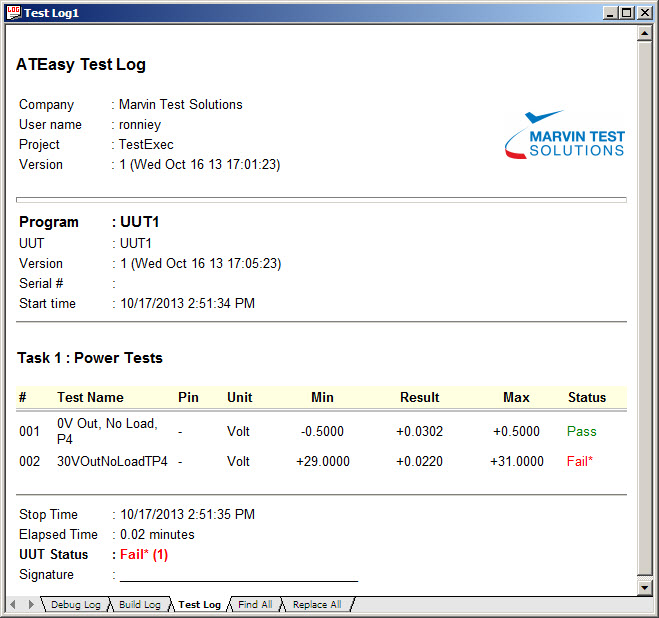You use the log window in the ATEasy development environment in either of the following scenarios:
You are developing ATEasy applications and need to check the output of your programs for testing and debugging.
You are running ATEasy applications under the ATEasy development environment, and need to check your test data.
The log window is a dock-able window with three tabs: the Test Log, Debug Log, and Build Log.
To display the log window:
From the View menu, select ![]() (Log). The log window displays:
(Log). The log window displays:

The Test Log Tab displays the test data or results generated by ATEasy when a program is running. It also displays any information that you route to the Test Log by using the Print Statement in your application code. The Test Log has two formats: Text, in which plain text is displayed; and HTML, in which text, tables and pictures can be displayed. In the illustration above, a test log is displayed in HTML format. For instructions on viewing the Test Log in text and HTML, see Logging Test Results.
Any debugging information generated by your application automatically goes to the test log. However, if you want to ensure that the test log contains only test data, you can route debugging information to the Debug Log. To route debugging information to the debug log, use the DebugLog.Append or trace statements. For more information, see Using the Log, TestLog, and DebugLog Internal Variables.
The Build Log tab displays ATEasy compilation information, including compiler error messages and any actions taken by ATEasy. This log is useful for debugging because it displays all information pertaining to the execution of code, including compiler errors.
When you right-click on the log window, the log context menu appears, displaying the following commands:
|
Right-click command |
What it does |
|
Select All |
Selects all text in the log. |
|
Copy |
Copies the selected text to the Windows clipboard. |
|
|
Prints the log. |
|
Refresh |
Refresh the log |
|
Clear |
Clears the log contents |
|
Save |
Saves the log |
|
Save As |
Saves the log in a HTML or text file, or Web Archive Single file (.mht) |
|
Find |
Finds text in the log. |
|
View Source |
Displays the log in ASCII text format. |